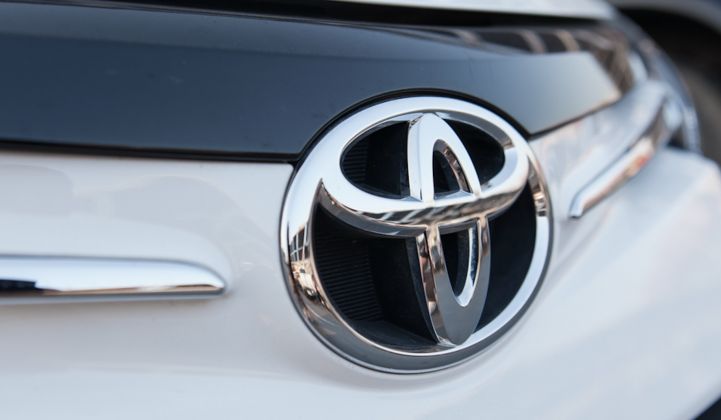Toyota plans to commercialize solid-state electric vehicle batteries by the early 2020s, Reuters confirmed this week.
If the Japanese automaker can pull that off, it could leap ahead of the competition in terms of energy density, range and safety.
Toyota popularized the turn away from internal-combustion engines with its Prius hybrid, but its clean transport innovation has slowed in recent years. The company maintained focus on hybrids and hydrogen fuel-cell cars, which other EV makers tend to dismiss as dead ends.
That policy came to an end late last year when Toyota launched an internal venture dedicated to commercializing a purely electric car. "Japanese automakers finally wise up to the electric future" was how auto blog Jalopnik reported that decision.
With Tesla, BMW, Nissan and Chevy scaling up EV production already, Toyota will have to hustle to catch up, and solid-state could certainly help. This advance represents something of a holy grail for battery makers, and has been notoriously hard to pull off.
First, here's the science of why we need solid-state in the first place, as told to me by Josh Garrett, CTO of Solid Power, which makes solid-state electrolytes.
"One of the main challenges with lithium-ion type technologies is, you can increase the energy and power, or you can improve or maintain your safety, but you can't do both," he said. "Solid-state is really the one known viable path toward increasing both at the same time."
Solid-state's safety properties could unlock a lithium-metal anode, which represents the chemical ideal in terms of how much charge it can store per unit of mass and volume. It's also highly volatile, as one may recall from dropping it into a beaker of water in chemistry class and watching it catch fire.
If you put a lithium-metal anode into the kind of battery cell made today, it suffers from uneven plating, which produces spiky protuberances known as dendrites. If a dendrite continues to grow, it can shoot across the cell's protective barrier layer and touch the positive electrode, causing a short, Garrett said. That generates lot of heat.
"The combination of your volatile electrolyte with the cathode materials, which are typically unstable and also contain oxygen, basically creates these thermal runaway reactions, and that's when you have a fire that you're probably not going to put out for a while," he explained.
Not a good look for mass-market consumer cars.
In solid-state, theory predicts more even plating, so dendrites shouldn't be much of a problem in the first place, Garrett said. If they do form, the more inert, non-volatile electrolyte denies the fuel that would stoke a fire. The individual cell could get hot and be ruined, but it will be "a very uneventful failure."
That's the quick version, at least. Many fine peer-reviewed publications beckon with the fully fleshed-out details.
It's important to note that actually achieving this vision will take a lot of lab work. One of many challenges is securing perfect contact for the flow of ions. A liquid electrolyte conforms easily to the electrodes, because it's a liquid against a solid. Two solids, not so much.
"Imagine two marbles put together: There's only going to be point contacts, and that really limits where the ions can travel between the electrolyte and the electrode," Garrett said.
As always with batteries, optimizing one characteristic, like connectivity or stability, can affect other aspects of performance. The key is achieving across-the-board improvements without sacrificing the necessities.
Solid Power, for now, is trying to commercialize its solid electrolyte combined with a lithium-metal anode and a more conventional nickel-manganese-cobalt lithium-ion chemistry. This design can produce an energy density increase of one-quarter to one-third at the cell level, compared to the cells in a Tesla Model S, Garrett estimated; additional gains are expected at the pack level.
Nobody has started mass-manufacturing solid-state rechargeable batteries yet, he noted -- but Toyota has assembled considerable resources behind that goal. The company is paying particular attention to the pack- and system-level improvements made possible by solid-state technology, which can then influence overall vehicle design.
Toyota will have to hustle to meet the early 2020s deadline, but the science is clear about what the payoff will be. Autonomous driving has been garnering considerable attention, but solid-state batteries could become the new automaker arms race to watch.



